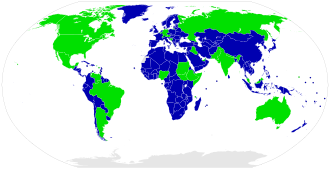
Back Föderalismus ALS فدرالية (توجه سياسي) Arabic ܦܕܪܠܝܐ ARC Federalismu AST Federalizm Azerbaijani فدرالیسم AZB Федерализм Bashkir Федэралізм Byelorussian Keserèkatan BEW Федерализъм Bulgarian

| Part of the Politics series |
| Politics |
|---|
|
|
| Part of a series on |
| Libertarianism |
|---|
Federalism is a mode of government that combines a general level of government (a central or federal government) with a regional level of sub-unit governments (e.g., provinces, states, cantons, territories, etc.), while dividing the powers of governing between the two levels of governments. Two illustrative examples of federated countries—one of the world's oldest federations, and one recently organized—are Australia and the Federated States of Micronesia, (Micronesia).
Johannes Althusius (1563-1638), is considered the father of modern federalism, along with Montesquieu. In 1603, Althusius first described the bases of this political philosophy in his Politica Methodice Digesta, Atque Exemplis Sacris et Profanis Illustrata. By 1748, in his treatise The Spirit of Law, Montesquieu (1689-1755) observed various examples of federalist governments: in corporate societies, in the polis bringing villages together, and in cities themselves forming confederations.[1] In the modern era Federalism was first adopted by a union of the states of the Old Swiss Confederacy[2] as of the mid-14th century.
Federalism differs from confederalism, where the central government is created subordinate to the regional states—and is notable for its regional-separation of governing powers, (e.g., the Articles of Confederation as the general level of government of the original Thirteen Colonies; and, later in the United States, the Confederate States of America). And federalism also differs from the unitary state, where the regional level is subordinate to the central/federal government, even after a devolution of powers—and is notable for regional-integration of governing powers, (e.g., the United Kingdom).[3]
Federalism is at the midpoint of variations on the pathway (or spectrum) of regional-integration or regional-separation. It is bordered on the increasing-separation side by confederalism, and on the increasing-integration side by devolution within a unitary state; (see "pathway" graphic).[4][5]
Some characterize the European Union as a pioneering example of federalism in a multi-state setting—with the concept termed a "federal union of states", as situated on the pathway (sprectrum) of regional-integration or regional-separation. [6][7]
Examples of federalism today, i.e., the federation of a central/federal government with regional sub-unit governments, include: Argentina, Australia, Austria, Belgium, Bosnia and Herzegovina, Brazil, Canada, Ethiopia, Germany, India, Iraq, Malaysia, Mexico, Micronesia, Nepal, Nigeria, Pakistan, Russia, Somalia, South Sudan, Sudan, Switzerland, the United Arab Emirates, the United States, and Venezuela.
- ^ Grabill, Stephen J. (2013). "Althusius in context: A biographical and historical introduction". In Althusius, Johannes (ed.). On law and power. Sources in early modern economics, ethics, and law. Translated by Veenstra, Jeffrey J. Grand Rapids, Michigan: Christian's Library Press. p. xx. ISBN 978-1-938948-59-6.
- ^ Forsyth 1981, p. 18.
- ^ Wheare 1946, pp. 31–22.
- ^
- ^
- Diamond, Martin (1961). "The Federalist's view of federalism". In Benson, George Charles Sumner (ed.). Essays in federalism. Claremont, California: Institute for Studies in Federalism. pp. 21–64, at p. 22. OCLC 615755.
- Downs, William M. (2011). "Comparative federalism, confederalism, unitary systems". In Ishiyama, John; Breuning, Marijke (eds.). 21st century political science: A reference handbook. Vol. 1. Thousand Oaks, California: Sage Publications. pp. 168–176, at pp. 168–170. doi:10.4135/9781412979351.n20. ISBN 978-1-4129-6901-7.
- Hueglin, Thomas O.; Fenna, Alan (2006). "Federal principles, federal organization". Comparative federalism: A systematic inquiry (1st ed.). Peterborough, Ontario, Canada: Broadview Press. pp. 31–84, at p. 31. ISBN 978-1-55111-410-1.
- ^ See Law, John (2013). "How can we define federalism?" (PDF). Perspectives on Federalism. 5 (3). Turin, Italy: Centro Studi sul Federalismo: 88–120, at p. 104. ISSN 2036-5438. Archived from the original (PDF) on 2015-07-15.
This author identifies two distinct federal forms, where before only one was known, based upon whether sovereignty (conceived in its core meaning of ultimate authority) resides in the whole (in one people) or in the parts (in many peoples). This is determined by the absence or presence of a unilateral right of secession for the parts. The structures are termed, respectively, the federal state (or federation) and the federal union of states (or federal union). - ^ Usherwood, Simon McDougall; Pinder, John (2018-01-25). The European Union: A very short introduction. Very short introductions (4th ed.). Oxford University Press. doi:10.1093/actrade/9780198808855.001.0001. ISBN 978-0-19-880885-5.